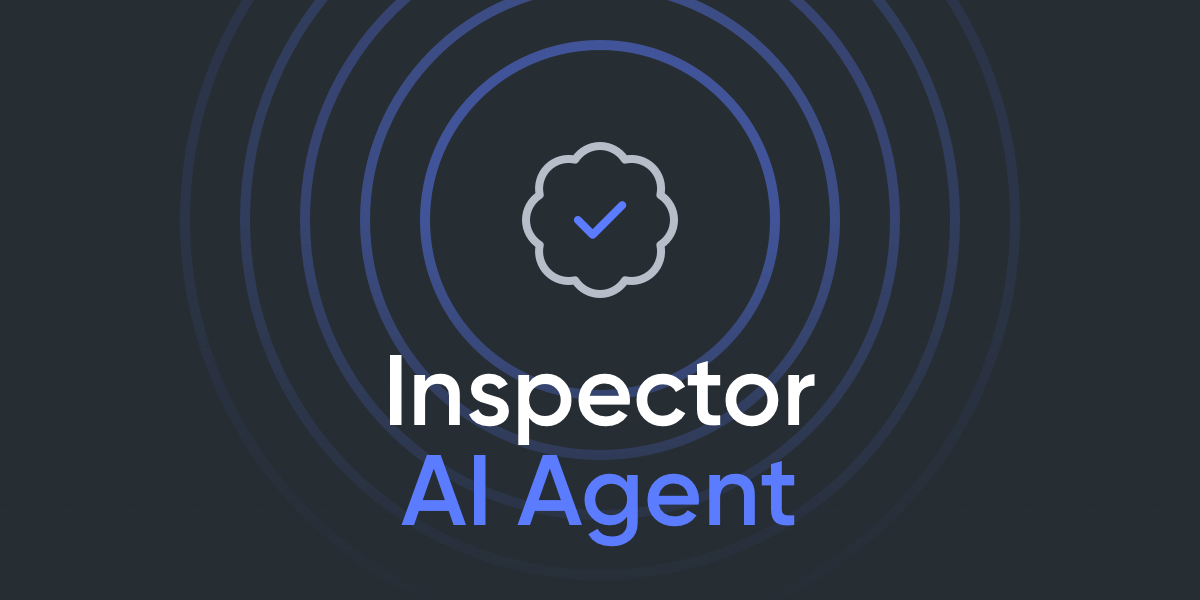Meet Inspector: aiXplain’s Runtime Governance Micro-Agent

What if your AI agents could enforce every compliance rule, security policy, and quality standard—automatically—during runtime, not after the damage is done?
Meet Inspector, a micro-agent for runtime governance. It sits inside the agent’s execution loop and applies compliance, security, and quality rules to every interaction.
Instead of relying only on dashboards and post-execution reviews, Inspector runs in the loop. It can intervene, correct, edit, block, or escalate in real time, and it records each decision as a structured trace. Governance scales with deployment—fast, deterministic, and auditable.
The Problem: Agents Are Easy to Build, Hard to Trust at Scale

You’ve built the perfect customer service agent. It handles inquiries brilliantly, generates responses that delight users, and operates 24/7 without complaint, until your healthcare agent accidentally includes PHI in a response, your financial bot drifts outside regulatory guidance, or your HR assistant uses an inappropriate tone on a sensitive request.
Now what? You’re pulled into a reactive governance loop:
- Manual dashboards that catch issues after the fact
- Slow escalations and reviews measured in hours or days
- Oversight effort that grows linearly with the number of agents and users
Runtime Governance That Scales
Inspector makes an architectural shift—as a result, policy is enforced in every interaction so governance is automatic, not manual. As content is generated, it can CONTINUE (log), RERUN (retry with feedback), ABORT (stop), EDIT (transform), or ESCALATE (human review). Each decision is written as a structured trace for audits.
Example: Attach a brand Inspector
# Define an Inspector
brand_inspector = Inspector(
name="brand_guardian",
description="Ensures responses align with brand voice",
evaluator=gpt4_model,
evaluator_prompt="Evaluate if this response maintains professional tone and aligns with our brand guidelines for customer communication.",
action=InspectorAction.RERUN(max_retries=3),
severity="high"
)
agent.inspectors=[brand_inspector] # Attach to agent
agent.inspector_targets=[InspectorTarget.OUTPUT] # Target checkpoints
# Example trace
{
"inspector": "brand_guardian",
"target": "output",
"severity": "HIGH",
"input": "Hey! So like, I totally...",
"output": "Good afternoon. I have reviewed...",
"finding": "Tone=casual",
"action": "RERUN",
"retries": 1,
"ts": "2025-11-11T17:12:03Z"
}This is fundamentally different from passive guardrails. Traditional guardrails observe and flag violations after they occur. Inspector is active governance—it intervenes during execution with the authority to block, correct, or transform content before violations reach production. Guardrails react. Inspector enforces.
Three Innovations That Make Runtime Governance Work
1. Evaluation and action: Separated, then unified
Inspector separates what checks content (AI classifiers, LLMs, programmatic rules) from what happens next (ABORT, RERUN, EDIT, CONTINUE). PHI detected? ABORT before response reaches users. Similarly, if tone is inappropriate, RERUN with specific feedback. This creates an autonomous governance loop—evaluation determines what’s wrong, action determines what happens next.
2. Precision targeting and severity
Inspectors can target specific checkpoints in the agent execution loop (e.g., at agent input, after agent execution, or final agent output)—applying policies exactly where needed. CRITICAL violations trigger immediate blocking. HIGH severity demands transformation or retry. MEDIUM allows limited retries. LOW logs without blocking. INFO powers pure analytics. Consequently, the system enforces deterministic compliance where it counts while maintaining velocity where it’s safe.
3. Chaining Inspectors: The conveyor belt of trust
Production deployments create governance pipelines where each Inspector sees the output of the previous one. Security checks run first, safety validators second, quality refiners third, analytics collectors last. Think of it as a factory assembly line where each station can pass the product, modify it, send it back for rework, or stop the line entirely.
From Security to Analytics: A Spectrum of Enforcement
Inspectors have been part of aiXplain’s architecture from the start and continue to expand in coverage and tunability.
Customers on aiXplain have built Inspectors for various use cases:
- Security and compliance: Government teams enforce classification levels. Financial institutions evaluate and mitigate prompt-injection/jailbreak attempts. Healthcare systems detect and reduce hallucinated medical information. The rule is deterministic, enforcement is automatic, audit trail is complete.
- Brand safety and quality: Media companies ensure content adheres to editorial standards. SaaS providers maintain consistent voice across customer touchpoints. Standards maintained through iteration.
- Content transformation: Cross-border operations automatically apply regional data masking. Enterprise support systems redact customer identifiers before logging. Legal teams enforce document sanitization before external sharing.
- Monitoring and analytics: Product teams track feature confusion signals. Customer success monitors sentiment shifts across agent interactions. Sales operations measure response quality by segment.
Use Case: The Self-Governing Financial Advisory Agent
Week 1: Basic deployment with three Inspectors—regulatory compliance blocker (ABORT on SEC violations), suitability checker (RERUN if advice mismatches client risk profile), and performance tracker (CONTINUE with analytics).
Month 2: The agent now handles 500+ client interactions daily. Performance tracker traces reveal patterns in client confusion around overly technical or overly casual language. The team adds an LLM-based tone calibration Inspector that evaluates confidence and tone, triggering RERUN with specific feedback to maintain an appropriate professional style.
Quarter 2: As usage continues to grow, the team adds a source citation validator to ensure all investment recommendations include proper disclosures and risk warnings before responses reach clients.
Year 1: At 5,000+ daily interactions across multiple advisory agents, policy checks are enforced automatically; edge cases escalate to compliance.
Financial advisor Inspector chain:
1. Regulatory compliance (CRITICAL) → ABORT on violations
2. Source citation validator (HIGH) → RERUN if disclosures or risk warnings are missing
3. Suitability checker (HIGH) → RERUN if advice mismatches client risk profile
4. Tone calibration (MEDIUM) → RERUN if tone or confidence is off
5. Performance tracker (INFO) → CONTINUE with analytics onlyWhat Inspector Enables
- Deploy faster with built-in compliance. Configure policies in natural language or import existing playbooks; increase complexity as needs evolve.
- Scale confidently. Reuse the same Inspector configurations across teams and agents; avoid manual review bottlenecks.
- Pass audits by querying traces. Inspector creates structured traces of every decision—what was checked, what was found, what action was taken; as a result, compliance becomes a search query, not a manual investigation.
- Adapt policies without redeployment. Update Inspector rules using natural language or programmatic logic. Changes apply immediately across all agents. No code changes. No redeployment cycles.
The Era of Self-Governing AI
Inspector closes the autonomy–control gap that is slowing enterprise adoption by enforcing policy at runtime, allowing agents to move from pilots to large-scale production deployments. It also controls the operational overhead of governance, so scale does not require a matching increase in manual supervision.
At aiXplain, micro-agents like Inspector and meta-agents like Evolver act as an internal agent workforce that manages both runtime behavior and ongoing evolution of customer agents, keeping them compliant and up to date as policies change across on-premises, air-gapped, hybrid, and cloud deployments.
We’re Just Getting Started
Inspector is production-ready today, but the potential for self-governing AI runs much deeper. On the roadmap:
- Interactive dashboards for real-time Inspector health and drill-downs
- Multi-Inspector orchestration to optimize chains by observed patterns
- Jurisdiction-aware governance by residency and location
- Adaptive policy learning via Evolver on edge-case feedback
Ready to trial runtime governance? Start building Inspectors or talk to our team.
 We have cookies!
We have cookies!